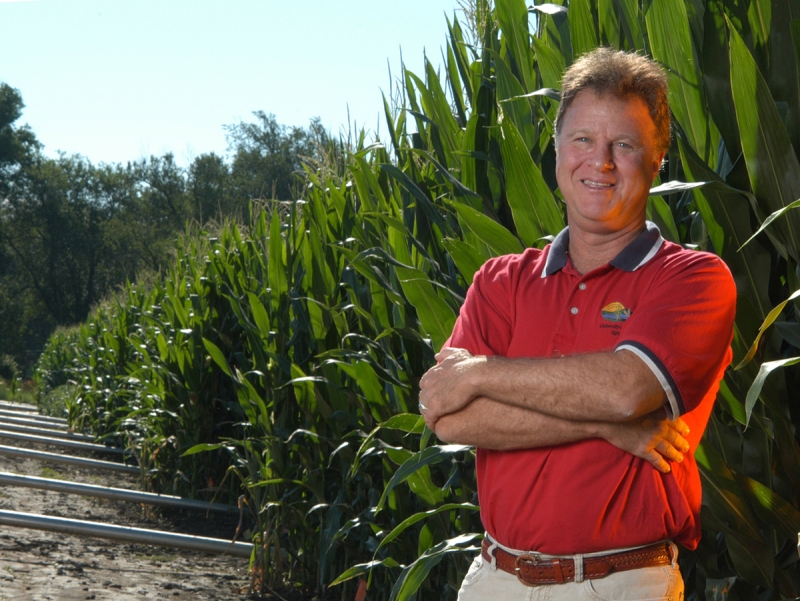
Contrary to conventional wisdom, irrigated corn in Nebraska is highly efficient in the use of energy, water and fertilizer, say University of Nebraska-Lincoln scientists whose research found that increased yields more than offset the energy cost of these inputs.
This research has important ramifications for agriculture's efforts to meet increasing global needs for food, feed, fuel and fiber on existing farmland, said Ken Cassman, UNL agronomist who holds the university's inaugural Robert B. Daugherty Professorship. Cassman and Patricio Grassini, a UNL research professor in agronomy and horticulture, co-authored a paper about their research that appears in this week's Proceedings of the National Academy of Sciences.
"If the goal is simply to reduce greenhouse gases or to have the highest possible energy efficiency, you'd do that producing crops without any inputs at all, or by getting rid of agriculture entirely. Of course that's not a tenable position," Cassman said. "The challenge therefore is how to produce enough food in a way that also protects the environment, conserves natural resources and minimizes the greenhouse gas emissions from agriculture."
The UNL research shows that modern, irrigated, high-input agriculture, though it uses more fossil fuels and generates more climate-change-causing greenhouse gases than rainfed systems, also produces much higher crop yields.
The widely held perception of irrigated agriculture as energy wasteful fails to take into account crop-management changes in recent decades that have increased yields without requiring more fertilizer or irrigation, Cassman said. Those changes have steadily boosted the energy efficiency of irrigated corn grown in the western Corn Belt and High Plains, including Colorado, South Dakota, North Dakota, Nebraska, Kansas, Oklahoma and parts of Texas, which accounts for about 15 percent of U.S. corn production.
"In fact, we found that irrigated corn had substantially larger net energy yield and less greenhouse gas emissions per unit of grain produced than corn from rainfed systems with much smaller input levels and lower yields," Grassini said.
The findings are based on several years' field data collected from a large number of commercial production fields in Nebraska's Tri-Basin Natural Resources District. This "rigorous on-farm assessment" is a first, Grassini explained. Previous research used secondary data gathered and extrapolated by the U.S. Department of Agriculture through producer surveys.
"In our study, each field has its own database. We could go back to the same field in 10 years and see how things have changed," Cassman added.
It's important to assess energy efficiency and GHG emissions of cropping systems on a yield basis, not a land-area basis, Grassini said.
To illustrate that point, Grassini said it would be possible to achieve a large decrease in GHG emissions in the three Nebraska counties included in this study by converting irrigated cropland into dryland agriculture, but to make up for the estimated 50 percent decrease in grain yield would require 308,000 additional acres of rainfed corn production in Nebraska.
"Thus it is penny-wise and pound foolish to convert irrigated agriculture back to dryland production for the sake of reducing greenhouse gas emissions," Grassini added.
"At some point, in a world with limited resources and confronted with emerging challenges such as climate change and limited supplies of fresh water, understanding how all of the world's agriculture performs in terms of net energy yield, greenhouse gas emissions intensity and water and nitrogen productivity is going to be important," Cassman said. "This paper sets standards on how you can do that using real-world farm data."
"The story of irrigated corn in Nebraska can be taken as a benchmark for other current and future irrigated cropping systems because it shows that achieving high yields, high energy efficiency, and low global warming potential are not mutually exclusive goals in real-world commercial farming," Grassini said.
The findings do not mean irrigated corn systems can't be made even more energy efficient, emphasized Cassman. Continued progress can come with use of best management practices, including rotation of corn with soybeans rather than continuous corn, replacement of surface irrigation with pivot irrigation systems, use of conservation tillage practices rather than conventional disc-plowing, and fine-tuning applications of nitrogen fertilizer and irrigation water.
UNL scientists now are conducting similar research on soybean production in Nebraska, Cassman said.
The article in the Proceedings of the National Academy of Sciences is titled "High-yield maize with large net energy yield and small global warming intensity."
This Agricultural Research Division research is funded by the Water, Energy and Agriculture Initiative of the Nebraska Center for Energy Sciences Research .
More details at: http://go.unl.edu/atr